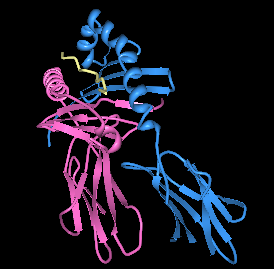This article may be too technical for most readers to understand. (May 2017) |
 Rendering of HLA-DQ8 with immundominant insulin peptide in the binding pocket. | |||||||||||||||||
| Polymer type | MHC Class II, DQ cell surface antigen | ||||||||||||||||
|---|---|---|---|---|---|---|---|---|---|---|---|---|---|---|---|---|---|
| |||||||||||||||||
| Rare haplotypes | |||||||||||||||||
| |||||||||||||||||
HLA-DQ8 (DQ8) is a human leukocyte antigen serotype within the HLA-DQ (DQ) serotype group. DQ8 is a split antigen of the DQ3 broad antigen. DQ8 is determined by the antibody recognition of β8 and this generally detects the gene product of DQB1*0302.
DQ8 is commonly linked to autoimmune disease in the human population. DQ8 is the second most predominant isoform linked to coeliac disease and the DQ most linked to Type 1 Diabetes. DQ8 increases the risk for rheumatoid arthritis and is linked to the primary risk locus for RA, HLA-DR4. DR4 also plays an important role in Type 1 Diabetes. While the DQ8.1 haplotype is associated with disease, there is no known association with the DQB1*0305, DQ8.4 or DQ8.5 haplotypes (see infobox) with autoimmune disease; however, this may be the result of lack of study in populations that carry these and the very low frequency.
DQ8.1 also differs from other HLA in population frequencies. Typically for MHC Class II antigens in humans, haplotype frequencies do not exceed 40%. For example, in the US the highest haplotype frequency, the haplotype that encoded DQ6.2, is around 15%, this translates into phenotype frequencies of less than 30%. Atypically haplotype frequencies exceed 40%.
For DQ8 the highest haplotype frequencies approach 80% in parts of Central and South America and the phenotype frequencies approach 90%. This is the highest phenotype frequency observed for any DR or DQ phenotype in the human population by a wide margin.
